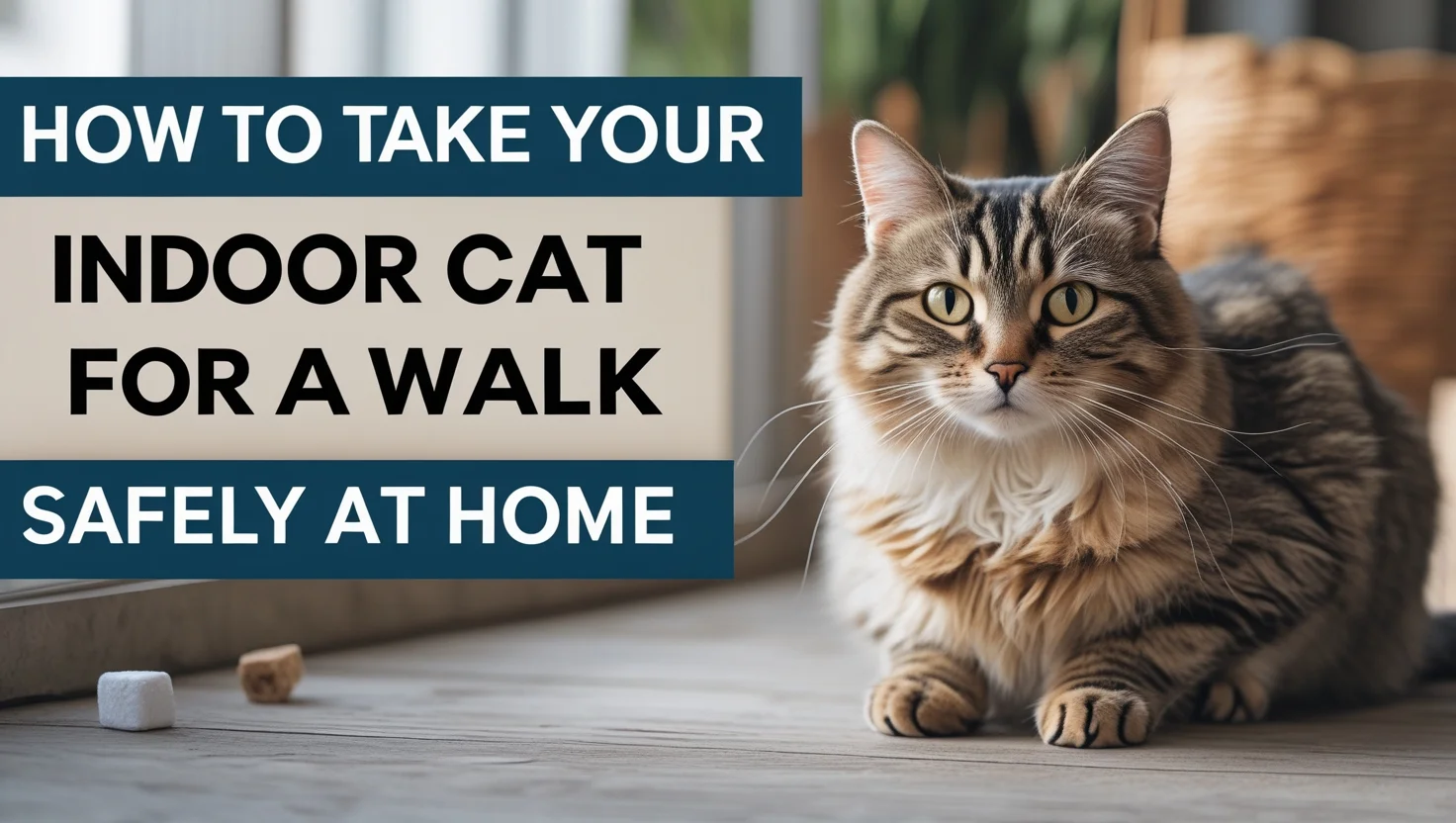Safe Indoor Cat Walks Made Easy
Because they remain indoors, there is a lack of activity and stimulation for many cats. Due to a new pet care trend called indoor cat walks, your feline friend can enjoy an adventure while staying safely indoors. Playing with your indoor cat is good for their body, gives them more things to do and builds stronger relationships. How do you apply it without harm and get the desired results?
This article covers all the tips you need to help your indoor cat enjoy a safe, comfortable and fun walk at home.
Why Indoor Cat Walks Are Important
When kept indoors, cats love to look for new places and sights. Being in a closed environment means they probably do not get enough mental or physical stimulation. Indoor cats may become bored and as a result start scratching furniture, over-cleaning themselves or sleeping more often. Having cat walks inside your home allows your pet to be active and happy, preventing some common issues that can happen outdoors such as getting hit by a car, parasites or encountering other animals.
Key Benefits:
- Physical Exercise: Physical Activity Helps Control Weight.
- Mental Stimulation: Exposes your pet to new environments, noises and experiences.
- Improved Behavior: Fewer problems with anxiety and bad habits.
- Bonding Time: Cat and owner bond when they spend time together.

Step-by-Step Guide: How to Safely Walk Your Indoor Cat at Home
1. Observe How Your Cat Acts
There are cats who aren’t comfortable with adventure or unfamiliar things. Check your cat’s behavior to determine if indoor cat walks are right for them:
- Is your cat curious or timid?
- Does your cat respond well to new environments or objects?
- Has your cat been trained or harnessed before?
Take it easy at first if your cat seems to be shy. Allow them to get comfortable with the situation gradually, without making them do things they are not ready for.
2. Choose the Right Harness and Leash
Don’t put a leash on your cat’s collar; it increases the risk of the cat choking or getting hurt. A harness designed for comfort and security is the better alternative than the collar. Look for:
- Adjustable straps
- Something that fits snugly, but isn’t too tight
- Soft padding
- Escape-proof design
As soon as the harness is fitted, add a light leash measuring 4 feet in length. It’s not a good idea to use retractable leashes for your cat indoors, because they can be unpredictable and might frighten the cat.
3. Familiarize Your Cat with the Harness
Cats should gradually get used to wearing a harness. Let your cat get acquainted with the bag while it is unplugged and turned off. After they feel more at ease:
- Loosely put the harness over your dog without securing it.
- For a short while, allow your cat to just wear the collar as it gets comfortable with it.
- Increase how long you wear your dentures every day a little at a time.
Offer your cat treats, give them a pat and praise them to help them relate rewards to good behavior.
4. Introduce the Leash Indoors
After your cat has grown used to the harness, add the leash. Wait a while before you try walking your puppy. Instead:
- Let your pet hang the end of the leash while you are nearby.
- Pay attention to their response when the load is added.
- Give your pet treats when it is calm.
If your cat looks at ease, take the leash and walk by their side in a gentle way.
5. Create a Safe Indoor Walking Path
Pick out a peaceful, quiet part of your house for your cat to relax in. A few fine choices are:
- A long hallway
- A big living room
- A room with everything you need removed
Take out any dangerous objects like glass, keep the room free of narrow nooks and exclude pets and distractions from your kitten’s view when you are there.
Place scratching posts, cat tunnels and catnip toys on the way to encourage your cat to continue.
6. Let Your Cat Lead the Way
Cats are not typically well known for going for walks when you ask them to. Your cat’s interest and happiness should decide the route for your indoor cat walk.
- Let your cat investigate areas in their own time.
- When your pet is sitting still, don’t try to pull the leash, just remain patient.
- Only encourage them if they look confused or uncertain of their approach.
Make movements enjoyable by using rewards or polite praise.
7. Keep Sessions Short and Sweet
Let new walkers exercise for 5–10 minutes at a time. If your cat is happy during the session, you may increase how long you spend training it.
Finish every walk with a nice treat or a game, so your cat looks forward to walks.

Safety Tips for Indoor Cat Walks
Treating safety with the same importance as having a fun time will help your pet:
- Microchip and ID Tags: Even when you are walking your cat inside, provide ID like a tag or microchip in case they leave through a door.
- Keep Doors and Windows Closed: Double-check the house is safe and secure when you take your pet out.
- Avoid High Ledges or Furniture: Keep your cat away from anything tall or hazardous such as ledges or furniture. Be careful to notice your surroundings.
- Supervise Closely: Don’t let your cat wear a leash or harness without someone watching them.
- Clean the Floor Area: Make sure the floor space is clear of all hazardous objects, loose cords and any form of chemicals for your cat.
Alternatives to Walking Inside
Even if your cat does not enjoy walking on a leash indoors, there are other activities you can provide:
- Interactive Toys: laser pointers, wand toys and puzzle feeders.
- Cat Trees & Tunnels: Cat Trees and Tunnels give your cat a good place to climb and hide.
- Window Perches: Adding Perches Allows Cats to Relax and View Nature from Inside.
- Catios: Provide a catio (a patio with walls) if you can, as it gives cats the opportunity to be outdoors, safe from dangers.
Common Mistakes to Avoid
People who love cats might mistakenly cause their pet stress during walks. Avoid making these usual errors:
- Trying to use the harness with the kitten too early
- Applying a dog leash or collar
- Remove the cat by pulling or dragging.
- Being in places that are very loud or not familiar
- Not recognizing when your pet is showing signs of stress
Always think about what brings your cat comfort and check if they are ready before doing anything.
Final Thoughts
Using an indoor cat walk allows your cat to exercise and have fun in safety. When you have a good harness, stay patient and have an indoor place your cat feels safe, walking together can be a lot of fun for both of you.
Keep in mind: cats have their own personalities. For some, walking is an instant habit, but for others, it takes quite a bit longer to get used to. Be patient, appreciate the little progress and most importantly, have a good time as a family.
Frequently Asked Questions (FAQ,s)
1. Is it safe to take my indoor cat for a walk inside my home?
Answer: Yes, indoor cat walks are a safe and effective way to provide your cat with physical exercise and mental stimulation without exposing them to outdoor hazards. Watching your cat when they wear a properly fitted harness and leash will keep them safe while they explore.
2. How do I train my indoor cat to walk on a leash at home?
Answer: Get your cat used to wearing the harness and leash slowly at first. Let your pet see and try on the harness inside for a short amount of time and give them treats and encouragement while doing so. After your pet is comfortable, put the leash on and let them roam around a safe area of your house. Patience and positive reinforcement are key to successful indoor cat walks.
3. What equipment do I need for indoor cat walks?
Answer: Get a harness designed for cats that doesn’t constrict them and a leash that’s around 4 feet in length to hold your cat. Not using collars for the leash helps you avoid any possible injuries or your cat escaping. Ensure the harness is secure and comfortable before starting any indoor cat walks.
4. How long should an indoor cat walk last?
Answer: Initially have short sessions for 5–10 minutes and raise the time as your pet starts to feel at ease. Observe your pet for signs it might be stressed or feeling tired and let them decide how fast or slowly they move. Regular, brief indoor cat walks can be more beneficial than infrequent, longer sessions.
5. What are the benefits of indoor cat walks?
Answer: Indoor cat walks offer numerous benefits, including physical exercise, mental stimulation, and environmental enrichment. They can help prevent obesity, reduce behavioral issues, and strengthen the bond between you and your cat. Additionally, walking indoors minimizes exposure to outdoor dangers like traffic, predators, and diseases.









